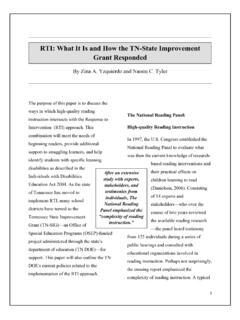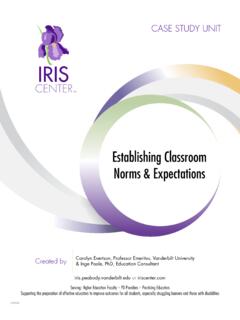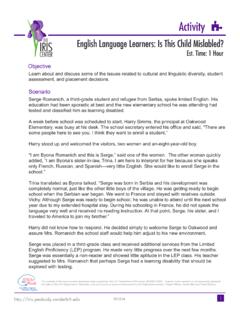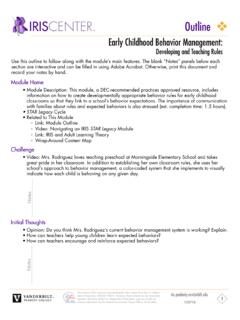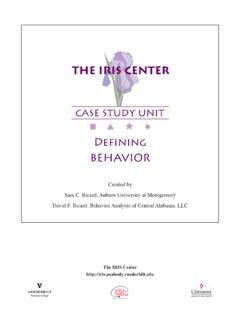Transcription of Encouraging Appropriate Behavior - IRIS
1 Or : Higher Education Faculty PD Providers Practicing EducatorsSupporting the preparation of effective educators to improve outcomes for all children, especially those with disabilities, birth through age 21with Instructor s Guide050117 Encouraging Appropriate BehaviorCASE STUDY UNITC reated byChristina M. Curran PhDCentral Washington University The contents of this case study were developed under a grant from the Department of Education, # H325F010003. However, those contents do not necessarily represent the policy of the Department of Education, and you should not assume endorsement by the Federal Government. Project Officers, Helen Thornton and Anne @CGU Technical Assistance and TrainingDeborah D.
2 Smith, EdD Co-DirectorClaremont Graduate UniversityPhone: (909) 607-8982 or (866) 626-IRIS [4747]Fax: (909) 607-0959 Email: @VU Modules and Materials DevelopmentNaomi C. Tyler, PhD Co-DirectorVanderbilt UniversityPhone: (615) 343-5610 or (800) 831-6134 Fax: (615) 343-5611 Email: Appropriate BehaviorContents: PageLicensure and Content Standards ..iiCase Study Level A, Case 1 ..1 Case Study Level A, Case 2 ..2 Case Study Level B, Case 1 ..3 Case Study Level B, Case 2 ..4 Case Study Level C, Case 1 ..5 STAR Sheet: Specific Praise ..6 STAR Sheet: Criterion-Specific Rewards ..9 STAR Sheet: Choice Making ..13 STAR Sheet: Effective Rules ..15 STAR Sheet: Contingent Instructions.
3 18 STAR Sheet: Group Contingency ..21 Instructor s Guide ..24To cite this Case Study Unit:Curran, C., & the IRIS Center. (2003). Encouraging Appropriate Behavior . Retrieved from of ContentsTable of ContentsFor an Instructor s Guide to this case study, please email your full name, title, and institutional affiliation to the IRIS Center at ii StandardsLicensure and Content StandardsThis IRIS Case Study aligns with the following licensure and program standards and topic areas. Council for the Accreditation of Educator Preparation (CAEP)CAEP standards for the accreditation of educators are designed to improve the quality and effectiveness not only of new instructional practitioners but also the evidence-base used to assess those qualities in the classroom.
4 Standard 1: Content and Pedagogical KnowledgeCouncil for Exceptional Children (CEC)CEC standards encompass a wide range of ethics, standards, and practices created to help guide those who have taken on the crucial role of educating students with disabilities. Standard 2: Learning EnvironmentsInterstate Teacher Assessment and Support Consortium (InTASC)InTASC Model Core Teaching Standards are designed to help teachers of all grade levels and content areas to pre-pare their students either for college or for employment following graduation. Standard 3: Learning Environments National Council for Accreditation of Teacher Education (NCATE)NCATE standards are intended to serve as professional guidelines for educators.
5 They also overview the organiza-tional structures, policies, and procedures necessary to support them Standard 1: Candidate Knowledge, Skills, and Professional DispositionsThe Division for Early Childhood Recommended Practices (DEC)The DEC Recommended Practices are designed to help improve the learning outcomes of young children (birth through age five) who have or who are at-risk for developmental delays or disabilities. Topic 5: Instruction Encouraging Appropriate BehaviorsEncouraging Appropriate BehaviorLevel A Case 1 BackgroundStudent: SamAge: : 8thScenarioSam is an eighth grader who is not finishing his work due to his off-task behaviors. According to his records, this has been an ongoing problem since third grade.
6 His grades have become progressively worse this year. His academic grade in his social studies class (and in most of his other classes) is at 65 percent because assignments are rarely completed or are done haphazardly. When Sam does start an assignment, he often rushes through it, making a number of errors and overlooking information. His teacher reports the following types of off-task behaviors: reading books and magazines, drawing and doodling, daydreaming, and talking to friends and neighbors. These behaviors occur most often during independent work times and rarely during large group or whole class activities. Having reviewed Sam s completed assignments and his class participation in group activities, Sam s social studies teacher believes he is capable of doing grade-level work and has decided that Sam will achieve the following goals within six weeks: Increase the number of independent assignments completed Earn 80 percent or higher on all completed assignmentsPossible Strategies Specific Praise Criterion-Specific Rewards Choice-Making!
7 Assignment1. Read the STAR Sheets on the possible strategies listed Write a summary of each strategy, including its Describe why each strategy might be used to help Sam meet one or more of his StudysEncouraging Appropriate BehaviorLevel A Case 2 BackgroundStudent: HeatherAge: : 3rdScenarioHeather is a third grader in Ms. Reyes classroom of 24 students. Heather enjoys school and often arrives early so she can spend time on the playground with her friends. Ms. Reyes, however, is concerned because Heather is disrupting the class. She reports that Heather calls out answers during lessons, speaks over others during class discussion, and talks to neighbors during group and independent work.
8 For 25 minutes each day, Heather and two peers receive resource room support in math. Heather s resource room teacher has not noticed any of these behaviors. Ms. Reyes decides to set these goals for Heather for the next nine weeks: Raise her hand and wait to be called before speaking Decrease interruptions and wait for others to finish before adding to discussions Complete independent work quietlyPossible Strategies Effective Rules Contingent Instructions Group Contingency! Assignment1. Read the STAR Sheets on the possible strategies listed Write a summary of each strategy, including its Describe why each strategy might be used to help Heather meet one or more of her StudysEncouraging Appropriate BehaviorLevel B Case 1 BackgroundStudent: DougAge: : 2nd Grade, 2nd SemesterScenarioDoug loves science and hands-on activities.
9 He is interested in dinosaurs and robots, and enjoys using the computer to play games. Doug has shared that he likes putting together Lego sets and has brought several in to the classroom to share. Doug, however, is not performing well at school. His teacher and parents are concerned. He is failing grade-level requirements in reading and math, even though he has tested at grade level in these areas. Doug does have an identified learning disability and receives resource room assistance in written expression. Doug gets easily frustrated when he has to copy and write assignments in any subject. He does have a computer available to use in the classroom as needed.
10 His second grade teacher, Mr. McGrady, believes Doug is capable of doing the work required in class. Mr. McGrady has noted that Doug participates in class discussions and hands-on activities; however, he avoids and rarely starts assignments by himself. Mr. McGrady reports that while other students begin assignments, Doug can be found fiddling with Lego gadgets and drawing robots. Getting Doug started on most independent activities is like pulling teeth. Based on this information, Mr. McGrady has selected these goals for Doug to achieve within the next three months: Begin independent work assignments promptly Increase the number of completed assignmentsPossible Strategies Specific Praise Criterion Specific Rewards Choice-Making Effective Rules Contingent Instructions Group Contingency!

